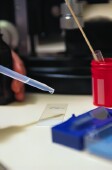 |
 |
 |
||
    |
||||
|
||||

Pancreatic Islets in Forefront of Diabetes Research
Cells could play major role in treatment, if supply is adequate, study finds|
|
HealthDay
By Robert Preidt
Tuesday, April 14, 2009
 TUESDAY, April 14 (HealthDay News) -- Pancreatic islets, which are hormone-producing cells, are becoming more prominent in diabetes research and could play a major role in future treatments, according to U.S. experts.
TUESDAY, April 14 (HealthDay News) -- Pancreatic islets, which are hormone-producing cells, are becoming more prominent in diabetes research and could play a major role in future treatments, according to U.S. experts.
"The primary objective of islet-based research is to cure diabetes," John S. Kaddis, of the City of Hope National Medical Center, in Duarte, Calif., and his colleagues wrote in the April 15 issue of the Journal of the American Medical Association, a themed issue on diabetes.
"Perhaps the most prominent clinical application of this research is currently in the form of cell replacement therapy," they noted. "With the exception of one report in a type 2 diabetes cohort, islet transplantation has been used exclusively for a subset of individuals with type 1 diabetes mellitus and was shown, at least temporarily, to improve glucose control and, in a few cases, to lead to insulin independence."
Cell replacement therapy involves the transplantation of pancreatic islets from a donated pancreas to a person with diabetes. The goal is to restore the function of beta cells in the pancreas. The destruction of these cells causes type 1 diabetes.
"Although islet transplantation has been shown to offer both protection against long-term complications of the disease and significant improvement in quality of life, several obstacles remain, such as limited engraftment [acceptance of the islets within the recipient], chronic immunosuppression and inconsistent supply of human islets," the researchers noted. "These issues must be addressed if the procedure is to be used as a standard of care for qualified individuals."
To meet the increasing demand for human islets for transplantation and research, islet-sharing networks have been established. Between September 2001 and August 2008, 297.6 million islets were produced by 14 laboratories in the Islet Cell Resource (ICR) consortium, with 67 percent of the islets used for basic science research and 31 percent for clinical purposes, according in background information in a news release from the journal.
"The importance of human pancreatic islets, clinically or for basic science research, is substantiated by the number and quality of studies being performed that rely on these preparations," the authors wrote. "Data available through the ICR as of August 2008 indicate that a total of 151 national and international scientists received human islets for use in both intramural research performed by the consortium as well as 182 clinical and basic science projects submitted to the consortium for support."
"Human pancreatic islets will be critical for restoration of beta-cell function in patients with diabetes," they concluded. "Even given adequate funding levels, the ongoing challenges to supplying human islets must be addressed for the successful exploration of therapeutic options for this chronic and debilitating disease."
HealthDay
Copyright (c) 2009 ScoutNews, LLC. All rights reserved.
Related News:
More News on this Date
Related MedlinePlus Pages:
| Home | Health Topics | Drugs & Supplements | Encyclopedia | Dictionary | News | Directories | Other Resources | |
| Disclaimers | Copyright | Privacy | Accessibility | Quality Guidelines U.S. National Library of Medicine, 8600 Rockville Pike, Bethesda, MD 20894 National Institutes of Health | Department of Health & Human Services |
Date last updated: 15 April 2009 |
